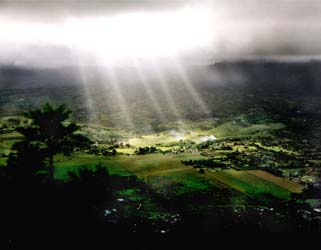 |
German
Immigration in the1880's Kaua'i, Hawaii |
 |
German
Immigration in the1880's Kaua'i, Hawaii |
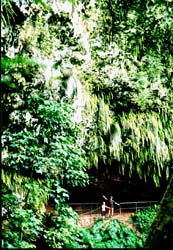 Kaua'i is known as the Garden Island.
The rather circular island is centered around Kawaikini Peak
(5,170 feet). Another peak nearby, Mount Wialeale, has an
average annual rainfall of 460 inches making it one of the
wettest regions of the world. Its "Fern Grotto" is one of the
islands primary tourist attractions. The lushness of the
greenery creates an environment that causes Kaua'i to be
considered by many to be one of the most beautiful of the
islands.
Kaua'i is known as the Garden Island.
The rather circular island is centered around Kawaikini Peak
(5,170 feet). Another peak nearby, Mount Wialeale, has an
average annual rainfall of 460 inches making it one of the
wettest regions of the world. Its "Fern Grotto" is one of the
islands primary tourist attractions. The lushness of the
greenery creates an environment that causes Kaua'i to be
considered by many to be one of the most beautiful of the
islands.
The natives here lived close to the land. For generations they cultivated taro-kalo (used for poi), coconuts, kuo,'ulu (breadfruit), 'uala (sweet potatoes),'ohi'a 'ai fruit (mountain apple), wauke(paper mulberry) plants and ko(sugar cane). The Polynesians apparently brought sugar cane with them when they settled in Hawaii but it was used primarily as a medicine. With the introduction of Europeans come also the introduction of European food plants and sometimes pests. Sugarcane production was looked at as a cash crop and native varieties were not productive enough. None of the native varieties are now grown on plantations.
Native Hawaiians had been put to work in the sugar cane fields from the beginning, however, the number of available workers was not enough to fullfill the needs for this labor intensive production. A number of laborers had been imported from China as early as 1852, as well as, from the South Sea islands. The Reciprocity Treaty of 1876 allowed Hawaiian sugar to enter the United States completely free of tariff duties. This economic incentive caused a growth in the number of sugar plantations and a need for more labor. On Kaua'i by 1880 the 90 laborers of the workforce of Lihu'e Plantation were still 60 percent Hawaiian. By this time, however, it became apparent that they needed more help and enlisted the agents of Hackfield and Company with offices in Northwestern Germany, the area of Bremen and Hanover. H. H. Hackfield apparently cut quite a figure with his two feet long white beard and apparently was quite a salesman. The Hawaii Immigration Board gave approval of all immigrants and even frequently subsidized the cost of the passage for the women and children.
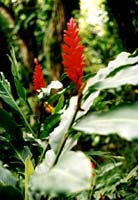
The first boat to ship out a load of German workers was the French built bark "Cedar" which left Bremen on January 4, 1881. "It was the finest ship ever entered the harbor of Honolulu", according to Jensen Blackstad. The ship manifest included twenty-one families of 128 individuals. H. Hackfeld paid 148$ each for 74 passengers. I'm uncertain about how the others had the passage paid. Among these were 4 Swedes and 10 Norwegians, the rest Germans. This first group didn't arrive in Honolulu until June 18th of 1881, making the voyage about six months long. The "Cedar" was apparently burned in a mutiny with a new American crew. The next year the "Ioloni" brought nearly 200 more workers and their families. The Germans from this group went to the island of Kilauea. In 1883 the steamer "Ehrenfels," in only a two months voyage, brought over eight hundred passengers. During this voyage, however, twenty-one children died. The surviving immigrants were divided between the plantations Lihu'e and Koloa. Several smaller groups of one to three families continued to arrive on other boats until 1897.
Among the first families to arrive in
Honolulu on June 18, 1881 were the Kiesel and
Blackstedt/Blackstad families. The entire voyage took six months
due, according to one story, to refit the ship after being
dismasted in one of several storms they must have encountered.
According to Jensen Blackstad they went up around Magellen to
Valparaiso, Chili. Just getting through the straits took almost
a month. There is no indication of a stop anywhere. When they
arrived in Hawaii the German's were not allowed to disembark on
Oahu because of a small pox epidemic. They instead had to remain
at anchor in the harbor. The others were eventually greeted by
150 natives "all dressed like Eve in Paradise", according to
Jensen Blackstad. The Germans were instead transferred to the
vessel "James Makee" which journeyed on to Kaua'i, Hawaii. There
they were met by Carl Isenberg, the German manager of Lihu'e
Plantation, and taken to his home by ox cart. The Stoffel family
probably came on the second boat although no records have been
found to prove this. [immigration records of Bremen, Germany and
immigration records to Hawaii after 1860,Hawaii State
Archives]
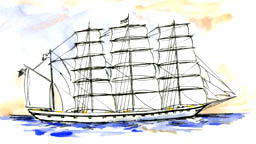 An unbelievably vivid
description of the voyage of the Cedar can be read in the
letter of Jensen Blackstad to his grand daughters.
An unbelievably vivid
description of the voyage of the Cedar can be read in the
letter of Jensen Blackstad to his grand daughters. By 1882 the workforce of Lihu'e plantation was up to 245. It consisted of 76 Chinese, 60 South Sea Islanders, 55 Hawaiians, 43 Germans and 11 Norwegians. Around 1885 pineapple plantations were started in Hawaii. In 1898 the sugar planters were able to convince the United States to annex Hawaii as a possession in spite of some native opposition. They knew that they would then receive a special payment for shipping sugar to the mainland. The islands eventually became a territory of the United State on June 14, 1900.
The German families here formed a strong community. They built their own church and established their own school on the Lihu'e Plantation with an imported German teacher. Fredrich Richter, a theology student who came on the first boatload, was not only the teacher but also the minister for the Lutheran congregation. The German language was spoken and taught for many years in both the school and the church.
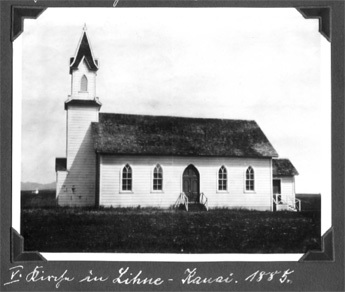
The school was operating until 1918 when the United States went to war and the Isenburgs were urged to close the school. At that time there were still thirty-five students. Through these institutions the culture and traditions of Germany were undoubtedly kept intact on Kaua'i. Records were kept of all the births of the early immigrants and are now in the Hawaii state archives. Very few of these immigrant families remain in Kuau'i today except through intermarriage with the native Hawaiians, Portuguese, Norwegian or other nationalities. Many of the families immigrated to the mainland to Washington, Oregon and California by the early 1900's as did most of my Kiesel and Schock families.
source:







All information and
photos included within these pages are here for the
express purpose of personal genealogical research and may
not be included or used for any commercial purpose or
included in any commercial site without the express
permission of Cheryl and Elroy Christenson. Copyright
Elroy Christenson 1998-2012.